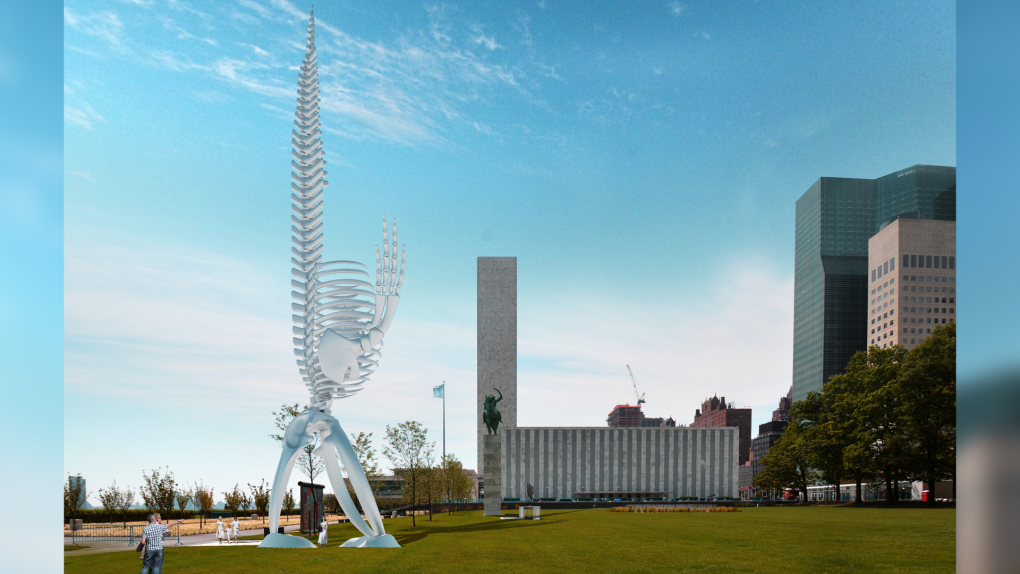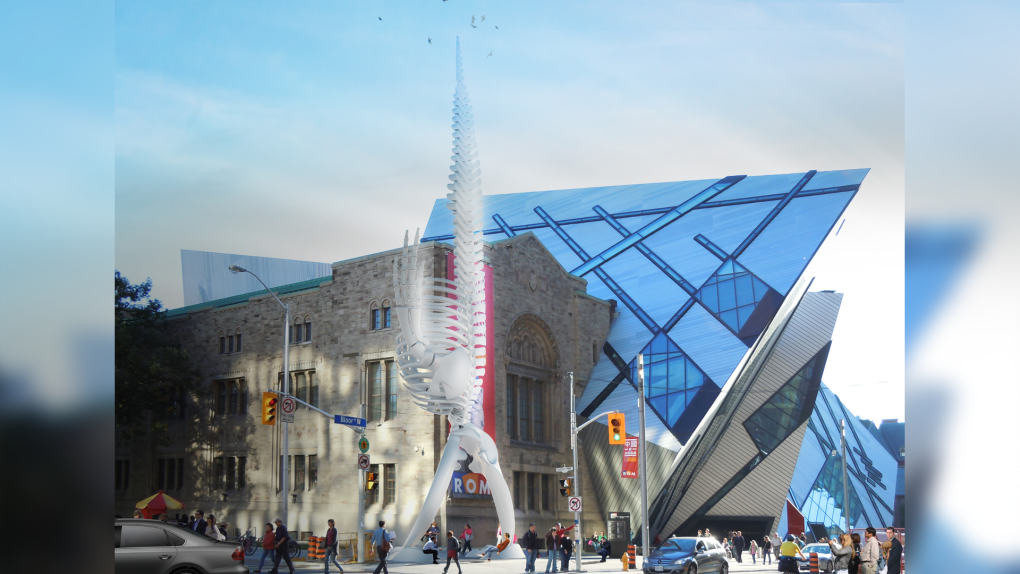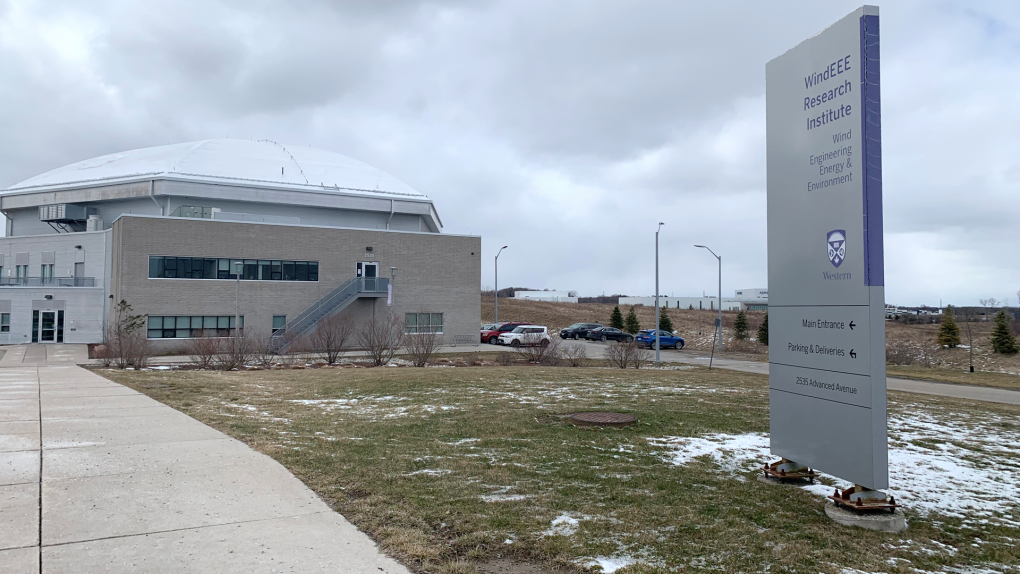Will the Standing Whale withstand the wind? Western University model testing a unique art piece inside WindEEE
A collaboration between world-renowned Canadian photographer Edward Burtynsky, Queens University, and Western University, is working to realize a new art piece titled ‘Standing Whale.’
A 3D printed stainless steel scale model is being put to the test inside the Wind Engineering, Energy, and Environment Research Institute (WindEEE RI) in London, Ont.
"One of a kind facility, not only in Canada, in a humble Canadian way, even in the world. It's very unique,” said Girma Bitsuamlak, director of WindEEE RI.
Inside WindEEE RI, engineers can simulate the impact of different types of high-force winds, including tornadoes, thunderstorm microbursts, and downbursts.
Engineers are working on testing the strength of a unique structure that is the work of Burtynsky, who hopes his public sculpture, a true-to-size re-imaging of a whale skeleton, will convey the importance of climate change, environmental stewardship, and biodiversity loss.
 Conceptual sketches of the ‘Standing Whale’ in front of the UN building. (Source: Edward Burtynsky photography)
Conceptual sketches of the ‘Standing Whale’ in front of the UN building. (Source: Edward Burtynsky photography)
But in order to make that happen, critical testing to determine the behaviour of the structure in the wind must be completed. The team has come to Western University, a leader in the world when it comes to wind engineering.
“We have 106 fans on the wall and the ceiling of the system. We control each fan individually. When you have this kind of flexibility and control, you can generate different kinds of wind systems. It's very unique in that sense," explained Bitsuamlak.
Burtynsky has been working with Think2Thing Design Director David Didur for nearly eight years to help conceptualize the Standing Whale.
“It’s through this collaboration we’re hoping to find a solution to have an aesthetically pleasing piece with no compromises, yet with sound engineering,” said Didur.
 Conceptual sketches of the ‘Standing Whale’ in front of the ROM in Toronto. (Source: Edward Burtynsky photography)
Conceptual sketches of the ‘Standing Whale’ in front of the ROM in Toronto. (Source: Edward Burtynsky photography)
Burtynsky is also working closely with Queens University, engaging with faculty and students in multiple programs, tackling the piece's structural and conceptual challenges with the aim of bringing this artwork to life in a public setting.
“We don’t have a facility were we can test the full scale sculpture, so what we have here is we have a 1 to 25 scale model. So the actual sculpture is 25 times bigger than the one you see here, and we scale the wind and all of the properties of the model so that we essentially get a realistic representation of what its behaviours will be here when we are done,” explained Josh Woods, civil engineering assistant professor at Queens University.
The data from the testing will allow the team to fabricate the 74-foot sculpture, a process that will take approximately two years.
A location for the unique art piece is yet to be determined.
 Exterior of the WindEEE facility in London, Ont. on March 20, 2024. (Reta Ismail/CTV News London)
Exterior of the WindEEE facility in London, Ont. on March 20, 2024. (Reta Ismail/CTV News London)
CTVNews.ca Top Stories

Mark Carney reaches out to dozens of Liberal MPs ahead of potential leadership campaign
Mark Carney, the former Bank of Canada and Bank of England governor, is actively considering running in a potential Liberal party leadership race should Justin Trudeau resign, sources tell CTV News.
'I gave them a call, they didn't pick up': Canadian furniture store appears to have gone out of business
Canadian furniture company Wazo Furniture, which has locations in Toronto and Montreal, appears to have gone out of business. CTV News Toronto has been hearing from customers who were shocked to find out after paying in advance for orders over the past few months.
WATCH Woman critically injured in explosive Ottawa crash caught on camera
Dashcam footage sent to CTV News shows a vehicle travelling at a high rate of speed in the wrong direction before striking and damaging a hydro pole.
A year after his son overdosed, a Montreal father feels more prevention work is needed
New data shows opioid-related deaths and hospitalizations are down in Canada, but provincial data paints a different picture. In Quebec, drug related deaths jumped 30 per cent in the first half of 2024, according to the public health institute (INSPQ).
Rideau Canal Skateway opening 'looking very positive'
As the first cold snap of 2025 settles in across Ottawa, there is optimism that the Rideau Canal Skateway will be able to open soon.
Much of Canada is under a weather alert this weekend: here's what to know
From snow, to high winds, to extreme cold, much of Canada is under a severe weather alert this weekend. Here's what to expect in your region.
Jimmy Carter's funeral begins by tracing 100 years from rural Georgia to the world stage
Jimmy Carter 's extended public farewell began Saturday in Georgia, with the 39th U.S. president’s flag-draped casket tracing his long arc from the Depression-era South and family farming business to the pinnacle of American political power and decades as a global humanitarian.
'A really powerful day': Commemorating National Ribbon Skirt Day in Winnipeg
Dozens donned colourful fabrics and patterns Saturday in honour of the third-annual National Ribbon Skirt Day celebrated across the country.
Jeff Baena, writer, director and husband of Aubrey Plaza, dead at 47
Jeff Baena, a writer and director whose credits include 'Life After Beth' and 'The Little Hours,' has died, according to the Los Angeles County Medical Examiner.


































